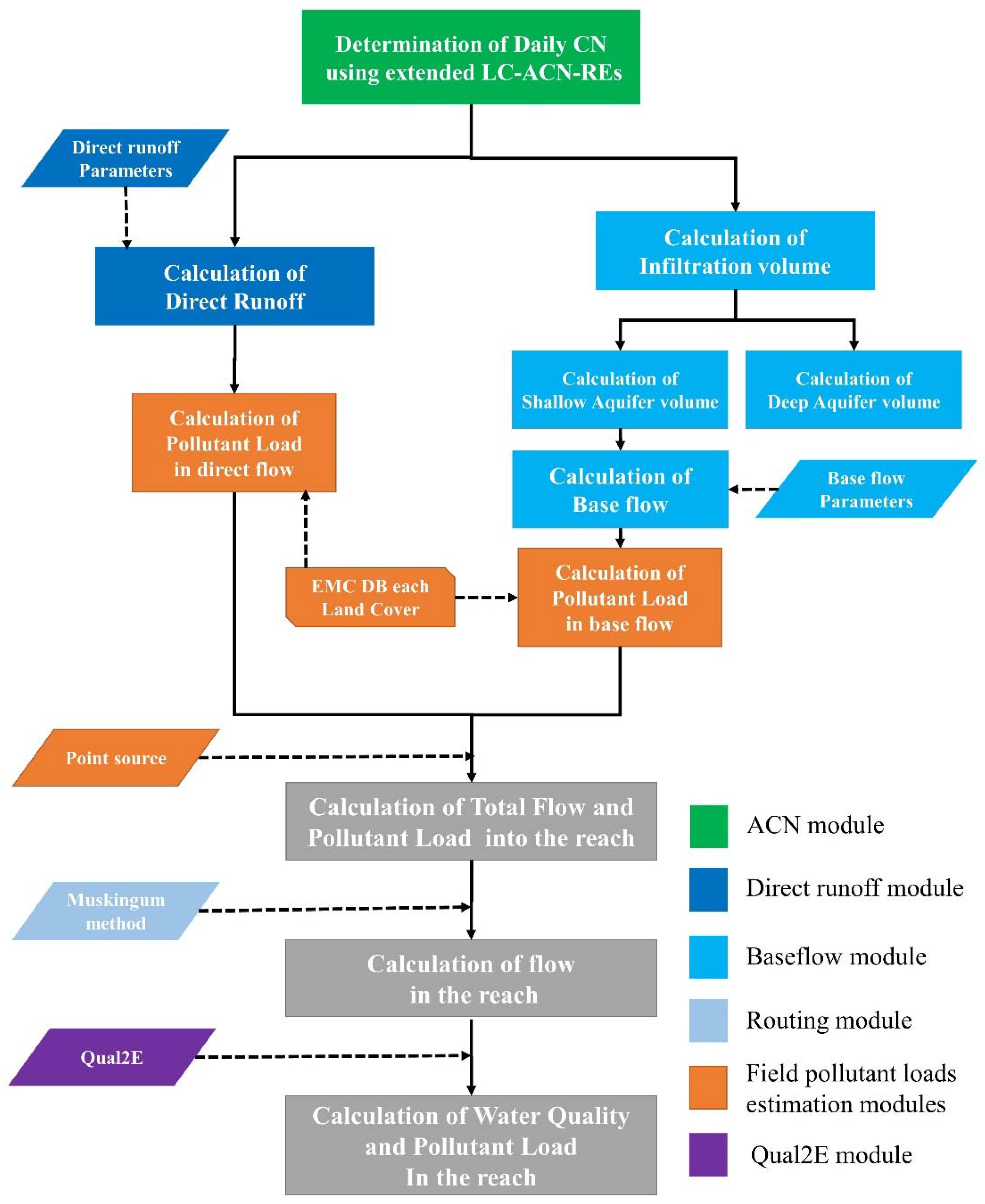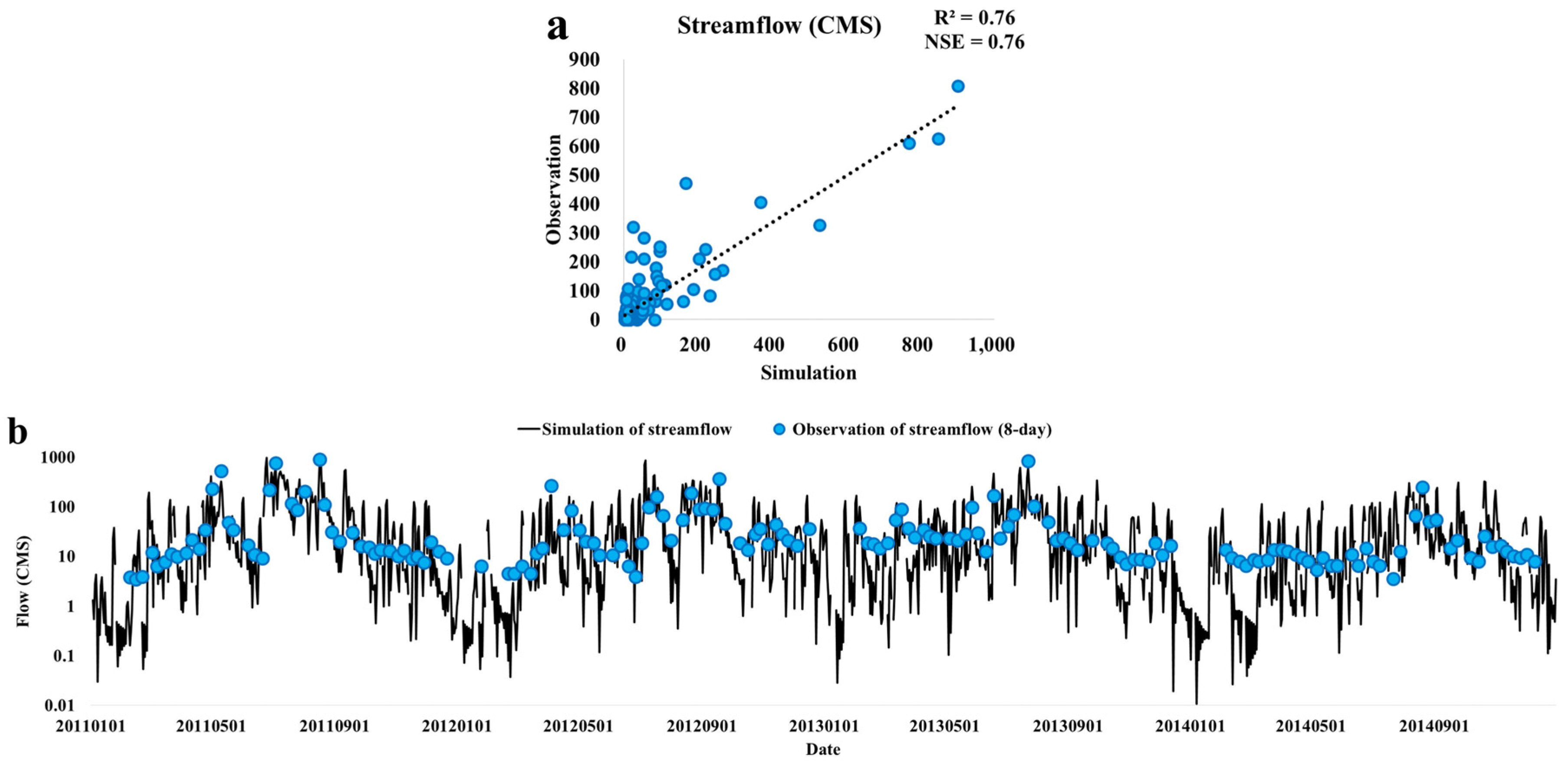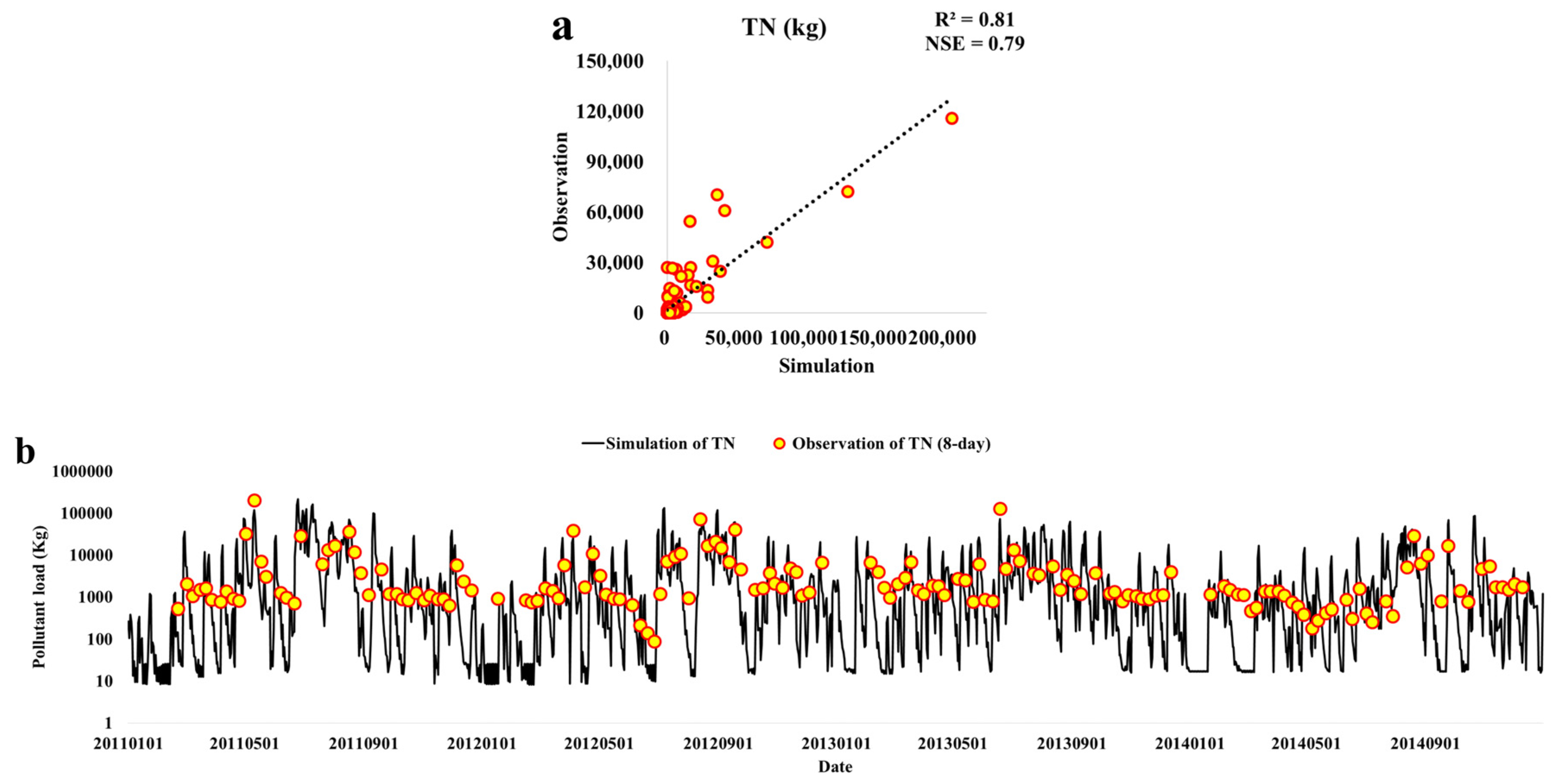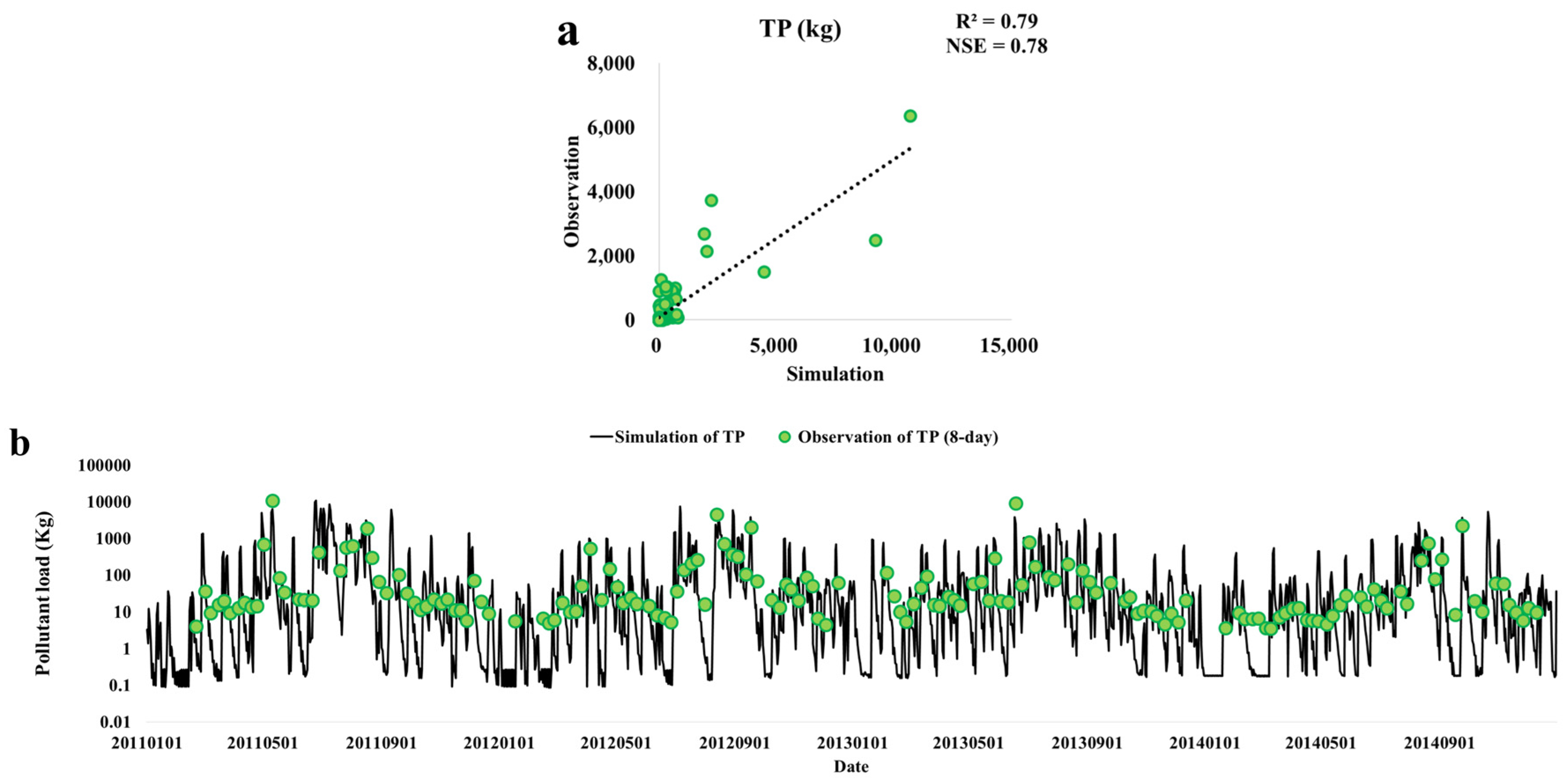2.1.1. Development of the Field Pollutant Load Estimation Module
To develop the field pollutant load estimation module, it is assumed that pollutant loads through direct runoff and baseflow should be estimated from each HRU, and move to the stream of each subbasin. For this, the
EMC data for direct runoff and baseflow components for various land cover types are needed. However,
EMC data on infiltration from various land cover types are not available in South Korea, as is the case in many other countries. Thus, pollutant load from the baseflow component was estimated by multiplying the baseflow by adjusted
EMC data. The adjusted
EMC data is calculated by multiplying the
EMC concentration by a user-defined coefficient to explain adsorption or degradation through soil and the loss of some portions to deep aquifers [
29]. The
EMC data were derived from monitoring data collected at various locations; thus, regional characteristics of
EMC should be considered when these
EMC data are applied. The
EMC adjustment coefficients were used in pollutant estimation from each HRU in this study (Equation (1)), which allows ease of model use, providing reasonable accuracy using a limited number of input parameters, similar to the original L-THIA model [
15,
16,
17,
18].
where
EMCDR is the pollutant concentration in direct runoff (mg/L),
EMCBF is the pollutant concentration in baseflow (mg/L),
EMC is the initial pollutant concentration of both direct runoff and baseflow (mg/L),
Adj_EMCDR is the adjustment coefficient for EMC in the direct runoff, and
Adj_EMCBF is the adjustment coefficient for
EMC in the baseflow.
The pollutant loads through either direct runoff or baseflow from each HRU (Equation (2)) are summed together for each subbasin (Equation (3)) and then these loads, later converted to concentration of pollutants, are used as input data to the instream water quality simulation (Equation (4)):
where
LDR,hru is the pollutant load of direct runoff (kg),
LBF,hru is the pollutant load of baseflow (kg),
EMCDR is the pollutant concentration in direct runoff (mg/L),
EMCBF is the pollution concentration in baseflow (mg/L),
QDR,HRU is the amount of direct runoff (m
3) discharged to the main channel, and
QBF,HRU the amount of baseflow (m
3) into the main channel:
where
LDR,sub is the pollutant load of direct runoff in subbasin (kg),
LBF,sub is the pollutant load of baseflow in subbasin (kg),
CDR is the pollutant concentration of direct runoff in the subbasin (mg/L),
CBF is the pollutant concentration of baseflow in the subbasin (mg/L),
QDR,sub is the amount of direct runoff discharged to the streams in the subbasin (m
3), and
QBF,sub is the amount of baseflow into the main channel in the subbasin (m
3).
The
EMC data from the “Project of the long-term monitoring for the nonpoint source (NPS) pollution”, monitored by the Ministry of Environment (MOE) in South Korea, were used (
Table 1) because the
EMC data for various land cover types and rainfall ranges are available in these datasets. The NPS pollution loads have been measured over seven years (2008–2015) in a small subbasin for thirteen representative land covers. The data compiled through this long-term monitoring project have information on NPS pollution, such as the amount and ratio of NPS pollution in runoff, and
EMC data [
30,
31,
32,
33]. In recent years, the MOE of Korea has determined the
EMC and unit loads for each land cover using the 7-year data from the project. The data were validated through government hearings [
34].
2.1.2. Incorporation of Simplified QUAL2E Instream Water Quality Model
In this study, the simplified QUAL2E model [
35], which has been widely used in one-dimensional water quality simulation, was added into the channel routing module of the watershed-scale L-THIA ACN model. The mechanism of instream water quality changes in the QUAL2E model is given in Brown and Barnwell [
35].
To simulate water quality through stream networks using the simplified QUAL2E, flow and pollutant concentration parameters from each subbasin must be prepared. Pollutant concentrations calculated in
Section 2.1.1 were classified as total nitrogen (TN) and total phosphorus (TP), without being further divided into specific categories such as nitrate nitrogen (NO
3-N), nitrite nitrogen (NO
2-N), ammonia nitrogen (NH
3-N), organic nitrogen (organic-N), organic phosphorus (organic-P), and inorganic-phosphorus (inorganic-P). However, for simulation of instream water quality changes, division into these categories is required.
Thus, pollutant concentrations of TN and TP in both direct runoff and baseflow were subdivided by partitioning coefficient parameters, which must be prepared by model users based on water quality data collected in the study watershed or nearby areas. After partitioning TN and TP, the six pollutant concentrations (NO
3-N, NO
2-N, NH
3-N, organic-N, organic-P and inorganic-P) of the subbasin, and of the direct runoff and baseflow, were used as input data for water quality simulation in streams, using the method in Brown and Barnwell [
23]. For the baseflow component, organic-N and organic-P were excluded because these nutrients have greater adsorption characteristics to soil particles while moving downwards from the surface. Only soluble pollutants can infiltrate into aquifers from the land surface [
29]. The QUAL2E model can only simulate carbonaceous biochemical oxygen demand (
CBOD), and not bottle
BOD5 (five-day biochemical oxygen demand); therefore, bottle
BOD5 of the subbasin calculated by Equation (4) was converted to
CBOD following Equation (5):
where
CBODu is the ultimate
CBOD concentration (mg/L), hereinafter referred as
CBOD, and
bottleBOD5 is the bottle
BOD5 concentration calculated by
Section 2.1.1 (mg/L),
NH3 is the ammonia concentration (mg/L),
A is the algal biomass (mg/L),
is the respiration rate of algae (day
−1),
knb is the nitrification rate coefficient in bottle
BOD5 at 20 °C (day
−1), and
kdb is the deoxidation rate coefficient in bottle
BOD5 at 20 °C (day
−1).
Since initial dissolved oxygen (DO) and algae pollutant concentrations required in QUAL2E are not available in the
EMC databases (
Table 1), the initial concentration of DO was estimated using the method proposed by APHA (Washington, DC, USA) [
36]. Changes in DO were calculated using the method in Brown and Barnwell [
35]. The amount of algal biomass is closely related to chlorophyll
a and can be derived by using its relationship with the concentration of chlorophyll
a [
37]. Chlorophyll
a concentration was derived by using a simplified version of the exponential function proposed by Cluis et al. [
37] (Equation (5)):
where
Chl is the chlorophyll
a concentration in the direct runoff (μ/L),
QDR,sub is direct runoff flow rate into the main channel (m
3/s),
TN is the total Kjeldahl nitrogen load (kmol),
TP is the total phosphorus load (kmol).
The initial concentration of DO was estimated using Equation (7) proposed by APHA (Washington, DC, USA) [
36]:
where DO is the saturation concentration of dissolved oxygen (mg/L), and
TempK is water temperature in Kelvin (273.15 + °C).
Water temperature was calculated using Equation (8) proposed by Stefan and Preud’ homme [
38]:
where
TempK is water temperature during the day (°C) and
Taverage is the average air temperature during the day (°C).
The initial concentrations of chlorophyll
a and DO in the subbasin were used for input data of the instream water quality component of the watershed-scale L-THIA ACN-WQ model. The mechanism of instream water quality changes in the QUAL2E model is shown in
Figure 2. More detailed description for each submodule of QUAL2E is explained below in details.
Weather data (e.g., solar radiation, duration of solar radiation and average air temperature) are required to simulate instream water quality changes using QUAL2E. A change in algae biomass in streams affects nutrient levels. The amount of algal biomass is simulated using solar radiation and duration as outlined by Brown and Barnwell [
35]. The watershed-scale L-THIA ACN-WQ model was modified to use the weather data for instream water quality simulation.
In the watershed-scale L-THIA ACN-WQ model, the
EMC data can be adjusted to consider local
EMC characteristics. The subdivisions of TN and TP were added to the model to simulate the NO
3-N, NO
2-N, NH
3-N, organic-P and inorganic-P in streams (
Table 2).
Pollutant loads in the stream were simulated using the QUAL2E model and the parameters in QUAL2E were used in the watershed-scale L-THIA ACN-WQ model (
Table 3). The default values of QUAL2E parameters were set in the model, as shown in
Table 3, with reference to studies of Glavan et al. and Na [
39,
40].
















